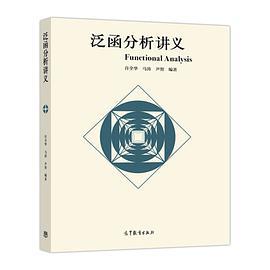内容简介
本书是一部数学经典教材,初版于1965年,以作者在东京大学任教十余年所用的讲义为基础写成的。经过几次修订和增补,1980年出了第5版,本版(第6版)实际上是第5版的重印版。全书论述了泛函空间的线性算子理论及其在现代分析和经典分析各领域中的许多应用。目次:预备知识;半范数;Baire-Hausdorff定理的应用;正交射影和riesz表示定理;Hahn-Banach定理;强收敛和弱收敛;傅里叶变换和微分方程;对偶算子;预解和谱;半群的解析理论;紧致算子;赋范环和谱表示;线性空间中的其他表示定理;遍历性理论和扩散理论;发展方程的积分。
读者对象:数学专业的研究生和科研人员。
作者简介
《泛函分析》(第6版)作者Kôsaku Yosida(吉田耕作,日)是东京大学教授,本书依据作者多年的教学讲义集结而成。即可作为学生的自学读本,也可作为泛函分析教材。
章节目录
0. Preliminaries
1. Set Theory
2. Topological Spaces
3. Measure Spaces
4. Linear Spaces
Ⅰ. Semi-norms
1. Semi-norms and Locally Convex Linear Topological Spaces
2. Norms and Quasi-norms
3. Examples of Normed Linear Spaces
4. Examples of Quasi-normed Linear Spaces
5. Pre-Hilbert Spaces
6. Continuity of Linear Operators
7. Bounded Sets and Bornologic Spaces
8. Generalized Functions and Generalized Derivatives
9. B-spaces and F-spaces
10. The Completion
11. Factor Spaces of a B-space
12. The Partition of Unity
13. Generalized Functions with Compact Support
14. The Direct Product of Generalized Functions
Ⅱ. Applications of the Baire-Hausdorff Theorem
1. The Uniform Boundedness Theorem and the Resonance Theorem
2. The Vitali-Hahn-Saks Theorem
3. The Termwise Differentiability of a Sequence of Generalized Functions
4. The Principle of the Condensation of Singularities
5. The Open Mapping Theorem
6. The Closed Graph Theorem
7. An Application of the Closed Graph Theorem (Hormander's Theorem)
Ⅲ. The Orthogonal Projection and F. Riesz' Representation Theorem
1. The Orthogonal Projection
2. "Nearly Orthogonal" Elements
3. The Ascoli-Arzela Theorem
4. The Orthogonal Base. Bessel's Inequality and Parseval's Relation
5. E. Schmidt's Orthogonalization
6. F. Riesz' Representation Theorem
7. The Lax-Milgram Theorem
8. A Proof of the Lebesgue-Nikodym Theorem
9. The Aronszajn-Bergman Reproducing Kernel
10. The Negative Norm of P. LAX
11. Local Structures of Generalized Functions
Ⅳ. The Hahn-Banach Theorems
1. The Hahn-Banach Extension Theorem in Real Linear Spaces
2. The Generalized Limit
3. Locally Convex, Complete Linear Topological Spaces
4. The Hahn-Banach Extension Theorem in Complex Linear Spaces
5. The Hahn-Banach Extension Theorem in Normed Linear Spaces
6. The Existence of Non-trivial Continuous Linear Functionals
7. Topologies of Linear Maps
8. The Embedding of X in its Bidual Space X"
9. Examples of Dual Spaces
Ⅴ. Strong Convergence and Weak Convergence
1. The Weak Cosvergence and The Weak Convergence
2. The Local Sequential Weak Compactness of Reflexive B-spaces. The Uniform Convexity
3. Dunford's Theorem and The Gelfand-Mazur Theorem
4. The Weak and Strong.Measurability. Pettis' Theorem
5. Bochner's Integral
Appendix to Chapter V. Weak Topologies and Duality in Locally Convex Linear Topological Spaces
1. Polar Sets
2. Barrel Spaces
3. Semi-reflexivity and Reflexivity
4. The Eberlein-Shmulyan Theorem
Ⅵ. Fourier Transform and Differential Equations
1. The Fourier Transform of Rapidly Decreasing Functions
2. The Fourier Transform of Tempered Distributions
3. Convolutions
4. The Paley-Wiener Theorems. The One-sided Laplace Transform
5. Titchmarsh's Theorem
6. Mikusinski's Operational Calculus
7. Sobolev's Lemma
8. Garding's Inequality
9. Friedrichs' ThEorem
10. The Malgrange-Ehrenpreis Theorem
11. Differential Operators with Uniform Strength
12. The I-Iypoellipticity (Hormander's Theorem)
Ⅶ. Dual Operators
1. Dual Operators
2. Adjoint Operators
3. Symmetric Operators and Self-adjoint Operators
4. Unitary Operators. The Cayley Transform
5. The Closed Range Theorem
Ⅷ. Resolvent and Spectrum
1. The Resolvent and Spectrum
2. The Resolvent Equation and Spectral Radius
3. The Mean Ergodic Theorem
4. Ergodic Theorems of the Hille Type Concerning Pseudo-resolvents
5. The Mean Value of an Almost Periodic Function
6. The Resolvent of a Dual Operator
7. Dunford's Integral
8. The Isolated Singularities of a Resolvent
Ⅸ. Analytical Theory of Semi-groups
1. The Semi-group of Class (Co)
2. The Equi-continuous Semi-group of Class (Co) in Locally Convex Spaces, Examples of Semi-groups
3. The Infinitesimal Generator of an Equi-continuous Semi-group of Class (Co)
4. The Resolvent of the Infinitesimal Generator A
5. Examples of Infinitesimal Generators
6. The Exponential of a Continuous Linear Operator whose Powers are Equi-continuous
7. The Representation and the Characterization of Equi-con-tinuous Semi-groups of Class (Co) in Terms of the Corre-sponding Infinitesimal Generators
8. Contraction Semi-groups and Dissipative Operators
9. Equi-continuous Groups of Class (Co). Stone's Theorem
10. Holomorphic Semi-groups
11. Fractional Powers of Closed Operators
12. The Convergence of Semi-groups. The Trotter-Kato Theorem
13. Dual Semi-groups. Phillips' Theorem
Ⅹ. Compact Operators
1. Compact Sets in B-spaces
2. Compact Operators and Nuclear Operators
3. The Rellich-Garding Theorem
4. Schauder's Theorem
5. The Riesz-Schauder Theory
6. Dirichlet's Problem
Appendix to Chapter X. The Nuclear Space of A. GROTHENDIECK
Ⅺ. Normed Rings and Spectral Representation
1. Maximal Ideals of a Normed Ring
2. The Radical. The Semi-simplicity
3. The Spectral Resolution of Bounded Normal Operators
4. The Spectral Resolution of a Unitary Operator
5. The Resolution of the Identity
6. The Spectral Resolution of a Self-adjoint Operator
7. Real Operators and Semi-bounded Operators. Friedrichs' Theorem
8. The Spectrum of a Self-adjoint Operator.Rayleigh's Prin-ciple and the Krylov-Weinstein Theorem. The Multiplicity of the Spectrum
9. The General Expansion Theorem. A Condition for the Absence of the Continuous Spectrum
10. The Peter-Weyl-Neumann Theorem
11. Tannaka's Duality Theorem for Non-commutative Compact Groups
12. Functions of a Self-adjoint Operator
13. Stone's Theorem and Bochner's Theorem
14. A Canonical Form of a Self-adjoint Operator with Simple Spectrum
15. The Defect Indices of a Symmetric Operator. The Generalized Resolution of the ldentity
16. The Group-ring L' and Wiener's Tauberian Theorem
Ⅻ. Other Representation Theorems in Linear Spaces
1. Extremal Points. The Krein-Milman Theorem
2. Vector Lattices
3. B-lattices and F-lattices
4. A Convergence Theorem of BANACH
5. The Representation of a Vector Lattice as Point Functions
6. The Representation of a Vector Lattice as Set Functions
ⅩⅢ. Ergodic Theory and Diffusion Theory
1. The Markov Process with an Invariant Measure
2. An Individual Ergodic Theorem and Its Applications
3. The Ergodic Hypothesis and the H-theorem
4. The Ergodic Decomposition of a Markov Process with a Locally Compact Phase Space
5. The Brownian Motion on a Homogeneous Riemannian Space
6. The Generalized Laplacian of W. FELLER
7. An Extension of the Diffusion Operator
8. Markov Processes and Potentials
9. Abstract Potential Operators and Semi-groups
ⅩⅣ. The Integration of the Equation of Evolution
1. Integration of Diffusion Equationsin LS(Rm)
2. Integration of Diffusion Equations in a Compact Riemannian Space
3. Integration of Wave Equations in a Euclidean Space Rm
4. Integration of Temporally Inhomogeneous Equations of Evolution in a B-space
5. The Method of TANABE and SOBOI.EVSKI
6. Non-linear Evolution Equations 1 (The Komura-Kato Approach)
7. Non-linear Evolution Equations 2 (The Approach through the Crandall-Liggett Convergence Theorem)
Supplementary Notes
Bibliography
Index
Notation of Spaces
泛函分析 第6版是2018年由世界图书出版公司出版,作者[日]K??saku。
得书感谢您对《泛函分析 第6版》关注和支持,如本书内容有不良信息或侵权等情形的,请联系本网站。

















